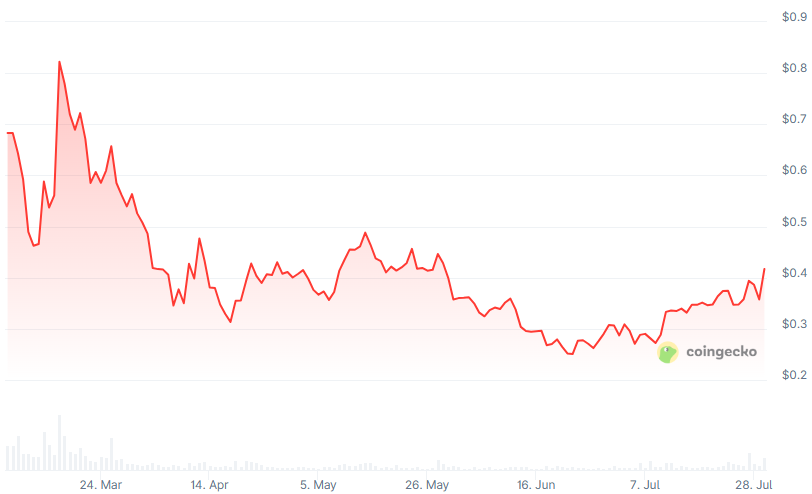RedStone Debuts Game-Changing Oracle with Built-In Liquidation Smarts—DeFi Just Got Smarter
Move over, legacy oracles—RedStone’s new protocol bakes liquidation intelligence directly into its data feeds, turning reactive price updates into proactive risk mitigation.
No more scrambling when markets tank. The system auto-detects undercollateralized positions faster than a Wall Street quant spotting a tax loophole.
How it works: Real-time asset valuations trigger smart contract liquidations before human traders can blink. Say goodbye to cascading defaults and hello to cleaner balance sheets.
DeFi purists will call it centralization creep. Pragmatists see survival evolution—because nothing screams 'maturity' like avoiding self-immolation during volatility.
One hedge fund manager yawned: 'Great, now crypto’s inventing the risk management tools banks had in 2008.' Progress hurts.
![]()
Validators or block builders typically compete to liquidate users during oracle lags, that way getting MEV. Notably, liquidation MEV has cost DeFi protocols more than $500 million, says the announcement.
Therefore, Atom captures “value at the source, inside the oracle LAYER itself.” It then sends the recaptured MEV directly to the protocol, which can then use it to lower interest rates/fees, improve yield, or further sustainability and incentives.
The new product enables Oracle Extractable Value (OEV) capture, zero-latency liquidations, and immediate onchain price updates. This, the team says, improves lending efficiency and does not require changes to existing protocol code.
Additionally, embedding MEV capture directly into the oracle layer, improves performance, capital efficiency, and sustainability, it claims.
Moreover, Atom is now securing all lending protocols on, and it’s ready to use on,,, and.
Meanwhile,, an application-specific sequencer by, powers Atom. This enables atomic MEV auctions, says the press release. It explains that “an ultra-fast auction (
Among the competing bidders, one will have the right to execute the liquidation. The bid is settled onchain with the price update. “It works across all EVM chains, requires no offchain components or centralized actors, and can be activated instantly,” RedStone says.
You may also like: Marcin Kazmierczak, Co-Founder of RedStone, on Blockchain Oracles and Tokenizing Private Credit | Ep. 442 In this episode of Cryptonews Spotlight, Marcin Kazmierczak, co-founder of RedStone Oracles, unpacks why oracles are more than just price feeds, how tokenized real-world assets are transforming finance, and why the tokenization of private credit might be crypto’s next trillion-dollar opportunity. From TradFi partnerships to DeFi infrastructure, Marcin explains how RedStone is building the data rails for the next financial era. The Market’s Back - But Builders Never Left “We’ve never...RedStone: ‘Whoever Liquidates First Wins’
The press release highlights the drawbacks of the traditional “push” oracles in DeFi lending. These update prices at certain intervals/events, which causes delays during market volatility.
And given that “whoever liquidates first wins,” this situation leads to missed liquidation windows and lost revenue, RedStone argues.
Therefore, Atom allows liquidators to trigger a real-time price update at the very moment they see a liquidation opportunity. The team noted several key benefits of this, primarily capturing “more liquidation opportunities faster than competitors.”
Others include better risk-adjusted returns to users, higher loan-to-value (LTV) ratios, and holding MEV “that WOULD otherwise leak to third parties.”
7/ Let that sink in: RedStone Atom demands *zero* integration effort.
Protocols keep their existing feed interface. No proxy feeds. No rewrites.
Simply request Atom on your RedStone feed, and let us coordinate the setup.
![]()
“Onchain lending is entering a new phase of competition, and protocols need innovative, yet reliable, infrastructure to stay ahead,” said co-founder Marcin Kaźmierczak.
He continues: “Atom flips the liquidation model on its head. Instead of third parties profiting from user liquidations, protocols can now decide how that value is shared, whether through incentives, yield boosts, or borrower rewards.”
Meanwhile, RedStone is a blockchain oracle provider delivering cross-chain data feeds to power DeFi protocols on,, and.
In March 2025, RedStone launched its native tokenon Ethereum.

Over the past 24 hours, the coin appreciated by 8.8% to the price of $0.4183.
It’s also up 14.4% in a week and 45% in a month.
It hit its all-time high of $0.9325 upon the launch, on 6 March, dropping 55% since.
You may also like: RedStone Selected as Official Blockchain Oracle for Securitize’s RWA Expansion with BlackRock Securitize, a company specializing in real-world asset (RWA) tokenization, has chosen blockchain oracle RedStone as its primary oracle provider. Notably, Securitize collaborates with major global financial institutions, including Apollo, BlackRock, Hamilton Lane, and KKR, to tokenize institutional-grade assets. According to the press release, the partnership will enable RedStone to deliver price feeds for Securitize’s current and future tokenized products. More precisely, RedStone...
